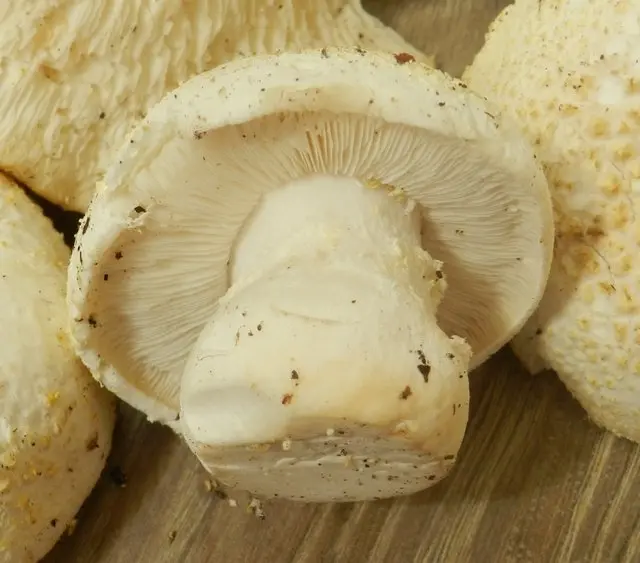Floccularia Ricken (Floccularia rickenii)
- Division: Basidiomycota (Basidiomycetes)
- Subdivision: Agaricomycotina (Agaricomycetes)
- Class: Agaricomycetes (Agaricomycetes)
- Subclass: Agaricomycetidae (Agaricomycetes)
- Order: Agaricales (Agaric or Lamellar)
- Family: Agaricaceae (Champignon)
- Genus: Floccularia (Floccularia)
- Type: Floccularia rickenii (Ricken’s floccularia)
:
- Repartitella rickenii

head 3–8 (up to 12 cm) in diameter, thick, fleshy at first hemispherical, with age convex prostrate, dry, matte, with concentric cone-shaped 3–8-sided warts (remains of a common veil) 0,5–5 mm in size, easily exfoliate when dried, the edge of the cap is curved, subsequently straight, often with the remains of a bedspread. First white, later creamy white, darker in the middle, greyish straw yellow or pale lemon greyish with a downturned edge.
Records Ricken’s flocculia adnate, or slightly descending on a stalk, thin, dense, white, then pale cream, with a lemon tint.
Leg: the color of the cap, cylindrical, strongly thickened below, 2-8 cm high, 1,5-2,5 cm in diameter. Naked above, covered from below by the remains of a common veil in the form of layered warts 0,5-3 mm in size. The ring is located at the top of the stem and disappears quickly.
Pulp: The pulp is dense, white, does not change at the break.
Smell: pleasant mushroom
Taste: sweetish
spore powder: cream, spores 4,0-5,5 × 3,0-4,0 µm, broadly oval, sometimes almost spherical, slightly pointed towards the base, smooth, colorless, often with a drop of oil.

May-October. Abroad distributed in Ukraine, Hungary, the Czech Republic and Slovakia; in Our Country in the Rostov and Volgograd regions, a rare species, listed in the Red Book of Ukraine and the Rostov region.
In Ukraine, it grows in artificial plantations of white acacia and in natural communities of Tatar maple (on the sands).
In the Volgograd and Rostov regions – in forests mixed with pine.
The data are contradictory: according to some sources, a tasty edible mushroom, according to others – an edible mushroom with low taste.
There are no similar species.
Photo: Vasily from Kamyshin









